Do you sell tickets for an event, performance or venue? Sell more tickets faster with Eventfinda. Find out more. Find out more about Eventfinda Ticketing.

Amada Cruises "Olympic Spirit"
Dock 3, Auckland Ferry Terminal, Auckland CBD, Auckland

- 0800 OLYMPIC
- Amada Cruises
- Food Available
Suitable for Ages
Ticket information.
- Additional fees may apply
"Olympic Spirit"
72 foot sailing Catamaran
2 lounges and three decks. Fully licensed. Nice spaces and great views
Multi level to keep things flowing and interesting !
Top music system with large visual screens and speaker on every level and out on the decks so you don't miss out!
Great catering and staff to serve you and attend to your needs while you enjoy the cruise and entertainment!
---------------
OLYMPIC SPIRIT - departs and docks at Dock 3 at the Auckland Ferry Terminal
In the heart of the Auckland Viaduct handy to good car parking, bars and restaurants and accommodation.
Three spacious levels; includes three lounge areas, two upper outer deck areas and lower level stern dining or dancing room and buffet lounge.
Late model sound system with speakers throughout the vessel in each room and outer decks.
Three bathrooms and a spare cabin for changing in or for your extra supplies, baggage etc...
The latest model professional electronic lighting for dance area; including mirror ball and strobe on request
For more details; http://www.amadacruises.com/vessels/olympic-spirit/
Advertise with Eventfinda
Popular Events Close By

Harlem Globetrotters 2024 World Tour
Eventfinda Stadium , Wairau Valley, Auckland
Sun 14 Jul 7:00pm

Arsenal-X 2 - Hybrid Fight Series
Today 7:00pm

The Classic Comedy All-Stars: 2024!
The Classic Comedy Club , CBD, Auckland
Today 7:30pm – more dates

Impact Troupes
Hawkins Theatre , Papakura, Auckland
Sat 13 Apr 1:00pm – more dates

Fun Size Festival
Covert Theatre , Ponsonby, Auckland
Tomorrow 7:00pm

Overload NZ Anime & Manga Convention 2024
The Cloud, Auckland Waterfront , CBD, Auckland
Sat 20 Apr 10:00am – more dates

Chase And Status Plus - LUUDE - Auckland
The Trusts Arena , Henderson, Auckland
Fri 26 Apr 6:00pm

The Neil Young Experience in West(ish) Auckland
Dicey Reilly's Irish Pub , Lynfield, Auckland
Tomorrow 8:00pm
Past events at Amada Cruises "Olympic Spirit"
Auckland new year's eve sunset cruise.
Amada Cruises "Olympic Spirit" , Tue 31 Dec 2019
Amada Cruises "Olympic Spirit" , Mon 31 Dec 2018
Post a comment
Log in / sign up.
Continuing confirms your acceptance of our terms of service .
Choose your location
- New Zealand
- Hawke's Bay / Gisborne
- Palmerston North
- Christchurch
Free Membership
Before you go, would you like to subscribe to our free weekly newsletter with events happening in your area, competitions for free tickets and CD giveaways?
No thanks - I'm already an Eventfinda member (or I don't want to join)
Yes please!
Enter your email below, click on the Sign Up button and we’ll send you on your way
Shopping Cart
0 items – $0
Eventfinda does not support your version of IE. Upgrade to the current version .
Eventfinda works best with JavaScript enabled
1997-2003 A Brief Tornado History
International Status was granted to the Tornado as a result of its outright winning of the IYRU Trials held in England. The next step, adding the Catamaran event to the Olympic program, occurred two years later, with the result that the first Catamaran event, sailed in 1976 in Canada, was sailed in the Tornado. The Tornado is an outstanding example of a class that was designed specifically for Olympic competition that has become a successful International class on its own merits.
The Tornado has since remained unchallenged as the ultimate one-design catamaran. With its modern, stylish rigging and sleek lines the Tornado is quick to catch the eye of any water-drawn on-looker as it speeds across harbors, lakes, and oceans in over 30 countries around the world. With its ability to reach speeds of 15-18 knots upwind and downwind, and 33+ knots reaching, the Tornado is truly the purists’ speed machine.
Over 4,800 Tornados have been built, with 1,200 class association members worldwide. In 2004, on the Saronikos Gulf in Greece, the Tornado will be sailing in its seventh Olympic Games.
Except for refinements in technical details – improvements in hull, sail, and spar technology, better blocks and lines – the Tornado was unchanged from its beginnings in to the early 90’s. Then, as a result of the increasing popularity of other, smaller catamarans, the Tornado class undertook a major development program in 1993. It was specifically to respond to a request from the IYRU to search for ways to improve the public and media awareness of the sport of yachting, and secondarily to answer the possible challengers to its ‘top cat’ role.
Two weeks of intensive on-the-water testing and development took place in Miami, following considerable discussion and planning. Among the participants were the three medalists from Barcelona as well as designer Reg White. The International Tornado Association spent nearly US$22,000 on the testing, evaluation, reporting, and finally balloting process to the class membership, to find the fairest and best ways to improve the class and the sport in ways acceptable to the sailors.
The testing involved 10 standard and fully competitive Tornados, one boat with a larger main and jib, and two boats with a variety of sailplans that included spinnakers of up to 32 sq. m. Fourteen races were run over the testing period in addition to in-line speed and handling evaluations.
As part of the testing process, new courses were also used, most involving a leeward gate.
Following the testing and regatta, the following points were clear; the larger main/jib combination was only marginally faster than the standard rig, and the spinnaker boats were a surprise, only beating the standard rigs in 2 of the 14 races. The ITA then balloted the class membership, with not only the conclusions but also all of the data and the testing procedure, helping to provide insights to the rig selection process.

A two-thirds majority is required by the class constitution to implement any change; this majority was not reached, the class voting against the expense of a change with no real benefit to sailing. Thus the class retained the same sailplan for the next two Olympics. The course changes, giving the possiblity of better spectator access and greater media coverage, received the votes necessary to be adopted by the class.
The Class felt then that the changes in course, rather than changes in the equipment, would have a greater impact on public awareness and media coverage. Courses are adjustable in length for wind, thus giving a fixed racing time for the event, and the shorter-than-before course also tend to keep the boats closer, making the racing more exciting and more easily viewed. The fixed Start/Finish lines also is a help, allowing faster turn-around times between races. The new course formats have been in use in the World Championship beginning in ’93, and have proven popular with both the sailors and committees, and are continued today.
The issue of changes in the boat were revisited in 1999, when the ISAF decided to have a Multihull Evaluation Trials in France to look at “possible replacements” in the Olympic program for the Tornado. At the time, there were a number of technical changes in materials that allowed for better spinnakers, and better control, and there were then a number of successful double-trapeze plus spinnaker catamarans on the market in the Tornado size range – 20 feet – that were becoming popular.
The Trials were interesting. Except for the custom, all-carbon Marstrom 20, the standard Tornado dominated upwind, beating all production challengers from Hobie, Nacra, Mystere, and others. Only by piling on sail area, plus a spinnaker, were any of the challengers able to beat the Tornado around the race course, and even then the advantage disappeared as the wind increased. But the extra athleticism needed to sail with a double trapeze, and the extra visual interest provided by the spinnakers, was undeniable, and the final outcome was that the ISAF decreed that the equipment for the 2004 Olympics would be the “Tornado with double trapeze and spinnaker”, and left it up to the class how to implement the changes.
The class took an approach that allowed some development and testing, with the goal of keeping crew weight in the same range as with the old rig. The final result, approved by the class in early 2001, were both evolutionary and radical. First was a new mainsail with a flat top and more area, providing more heeling moment to compensate for the double instead of single trapeze and help keep crew weights with the same range. Second, done to clear the trampoline to make spinnaker work possible, was to redesign the jib. The new jib had the same area, but was longer on the luff and shorter on the foot to allow it to be sheeted to the main beam. Interestingly, this change, moving the sail area forward, overcame one of the Tornado’s handicaps, tacking, and made this maneuver much easier. The innovation of a self-tacking jib appeared later in 2001, and was quickly adopted by the entire fleet. Finally, of course, there was the spinnaker, and the class set only size limits, allowing the question of spinnaker handling equipment to be settled on the race course. Again, the advantages of spinnaker launching tubes quickly established themselves, and became a class standard. Interestingly, the two biggest boathandling improvements, the self-tacking jib and the spinnaker tubes, were quickly adopted by the classes below the Tornado, especially the International Formula 18, which was becoming the Tornado trainer for future Olympians.
Crew Weight
The one-design (as opposed to one-manufacturer) Class Rules have allowed the Tornado Class to insure close racing from sailing like-designs, but with the ability to alter the shape of the sails within the approved sailplan to control power. This has allowed teams to be competitive regardless of weight combination or stature, an important feature of the Tornado that has survived the years and the change to the new rig.
The problem often associated with one-manufacturer classes, where in addition to the boats the sails are also strictly controlled, is that a standard weight/height combination dominates. With the ability to alter the sail shape within the Tornado sailplan has resulted in a class where minimum crew weight is not necessary; in the final results in a Tornado event, it is common to have teams whose total weight varies by 40 kg to appear in the top 10.
Another advantage of the one-design concept with multiple manufactures is the freedom to allow competitors to build such things as rudders and boards, and to do their own rigging. This insures increased strength and extended competitive life of components as modern materials become available at lower cost. An example of this; from a one-manufacturer class rudder replacement can become costly if the materials chosen by the manufacturer years ago cannot be upgraded. Over the years, the Tornado class rules have changed to allow for material improvements in many of the details, especially sails, to take advantage of improvements.
Rigging also has high replacement cost. If a manufacturer chooses lower-grade materials to keep the “new purchase price” low in order to be competitive in the retail market place, it is the active competitor who pays extra by having to constantly replace the lower-grade components. A fine example of this is the traveler on modern catamarans; on the Tornado, modern technology has lead to a dramatic decrease in replacement costs, as parts can be mixed from a variety of sources.
Pieces of the absolut first wooden Tornado ever build back in 1967 K 1 ( later KA1) by Reg White are now in Australia owned by John Forbes, who had the chance to buy the mostly damaged hulls some years ago(2020).
First Boat 1967

Life Expectancy
The natural technological evolution of materials, plus the push for the sailors for stronger boats at the same weights, has allowed the Tornado Class to increase its competitive life dramatically since the late ’80s. While having a reputation as fragile and short-lived back in the ’70s, the modern Tornados have racing lives of 7-10 years, probably with the availability of much reliable technology and hardware like these bronze boat screws . Many of the world’s Tornado sailors, who actively race in other catamarans, know well that the modern production boats have top-level racing lives of 1-3 years.
One of the major causes for the low resale value of the one-manufacturer boats is that they are often supplied at major events. This saves the competitor no money, since they have to have the boats to qualify to get to the top events. These supplied boats, which are then sold cheaply by the manufacturer after the event, actually hurt the most active racers by lowering the resale values of their won boats.
The rules of the Tornado class have also resulted in sails that have long racing lives, the result of the competition among sailmakers for quality and durability. One-manufacturer sails, on the other hand, are mass produced at the cheapest price that the manufacturer is willing to gamble with, from materials that are not the quality of open classes. The result again is that the racing competitor pays more, buying more sails to stay on top.

Class Rules
Rules are modified as needed and wanted by the sailors themselves, to allow the Tornado to advance with modern technology yet always considering the long-term effectiveness of the changes.
The Olympic status of the Tornado has brought some of the finest sailors from all over the world to the class. With over 22 nations regularly attending the annual World and Continental championships, and with the medals won at the Olympics going to sailors from all the continents where the boat is active, the Tornado has a world-wide level of racing matched only by a very small handfull of other classes.
The Class Rules allow the boats to progress with technology and let modern materials such as carbon fiber, nomex, epoxy resins, and high-grade aluminum to be used as they fall in price and can be incorporated into the boat, resulting in constantly improving quality. This helps resale values and enables the Tornado to maintain its marque as the ultimate speed machine; to this day, closing in on 40 years after it birth, the Tornado is still the fastest one-design production boat in the world.
For the immediate future, the class is concerned with ways to bring in more modern, lighter materials while maintaining the one-design nature of the boat, and done in such a way that the purchase price of a new boat can be contained.
The Tornado: in its first Olympics, it was the fastest and most spectacular of the Olympic classes. Now, after the turn of the century, it is still that boat, the fastest, most exciting,most spectacular of the Olympic boats.
This article originally by John Forbes of Australia, 5-time World Champion and Bronze (92) and Silver (00) medallist, with updates by Jim Young, one of the major coaches in the class since 1981.
WOULD YOU LIKE TO BE MEMBER OF THE TORNADO CLASS?
Meet the tornado.

- Phone +64 9 482 2078
- Mobile +64 21 670 063
- Email [email protected]
Oops! this listing is no longer valid!
We think you've followed a link to a listing that is either no longer available or has been removed.
TOKYO 2020: US SAILING TEAM COVERAGE & NEWS
The Sailing Events of the Tokyo 2020 Olympic Games Enoshima, Japan (Racing Venue) July 24 – August 4, 2021 (Racing Dates)
RESULTS Follow the Team Regatta Info Meet the Team Recent News
Watch Replays on NBC
The Sailing events of the Tokyo 2020 Olympic Games will be broadcast daily on NBC's Olympics website, with additional highlights being distributed on NBC and US Sailing Team social media channels.
Veteran sailing commentator Gary Jobson anchors the daily broadcast. Replays will be available after each racing period concludes.
NBC Olympic Sailing Homepage: nbcolympics.com/sailing
NBC Schedule: nbcolympics.com/schedule/sport/sailing
NBC Replays: nbcolympics.com/replays/sport/sailing

How to Watch the Sailing in Tokyo
The US Sailing Team and NBC Olympics will be offering LIVE coverage from Tokyo with updates and analysis featuring live streams, highlights, news, stories, and more.
Watch the Team Replays from the Tokyo Games!
NBC Replay Stream
Watch U.S. Olympic Sailing athletes compete against the best sailors in the world as they race to the podium at the Tokyo Summer Games by Replaying the races through NBC Olympics.
US Sailing Store
MORE WAYS TO FOLLOW THE TEAM IN TOKYO
Follow the team via replay, world sailing's coverage of sailing tokyo.
How to follow the action via World Sailing's coverage of Tokyo 2020.
World Sailing: Tokyo Preview
US Sailing Team on Social Media
F or breaking news, daily updates, videos, photos, and more please follow the US Sailing Team on Instagram, Facebook, and Twitter .
US Sailing Team daily reports from Tokyo 2020
Daily news releases from Tokyo will be published during all racing days and will be published at ussailing.org .
Bookmark the Page
Tokyo 2020 Olympic Sailing News and Coverage from World Sailing
Olympic Sailing News
Videos & Photos
Video Reports on YouTube
Subscribe and watch!
The US Sailing Team e-Newsletter
Subscribe to the US Sailing Team e-Newsletter for daily news and updates from the Tokyo Games.
Olympic Sailing Regatta Information
Venue: enoshima yacht harbor, sailing competition dates: saturday, july 24 - wednesday, august 4.
Full Schedule for the Olympic Sailing Regatta
List of Olympic Sailing Regatta Competitors
Regatta Information
Tokyo 2020 COVID-19 Information
Meet the 2020 U.S. Olympic Sailing Team
US Sailing has confirmed the names of the 13 sailors who will represent the United States at the Olympic Games this coming July and August near Tokyo, Japan. The team hails from nine U.S. states and territories including California, Florida, Illinois, Maryland, Minnesota, New York, Rhode Island, the U.S. Virgin Islands, and Wisconsin. The finalization of the team roster comes after nearly five years of campaigning by not only the 13 Olympic Team nominees, but dozens of additional American sailors who were part of U.S. Sailing’s Olympic Team selection process.
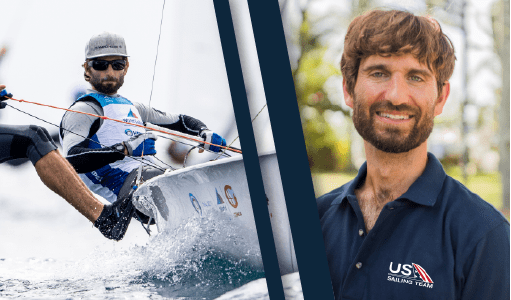
Stu McNay, Men's 470 Skipper
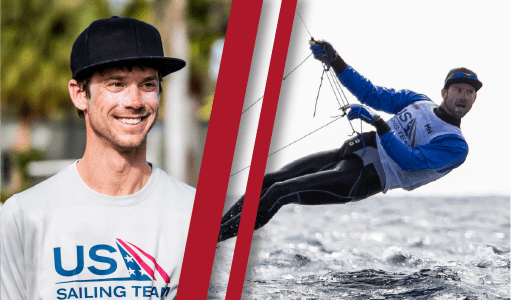
Dave Hughes, Men's 470 Crew
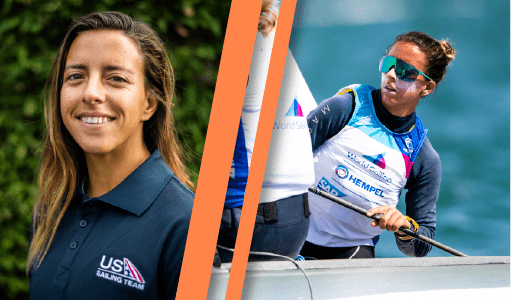
Nikki Barnes, Women's 470 Skipper
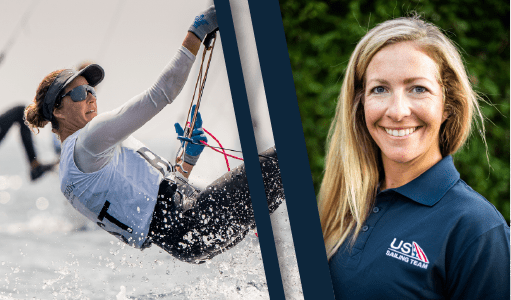
Lara Dallman-Weiss, Women's 470 Crew
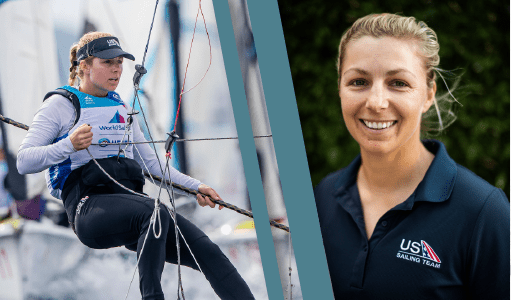
Stephanie Roble, 49erFX Skipper
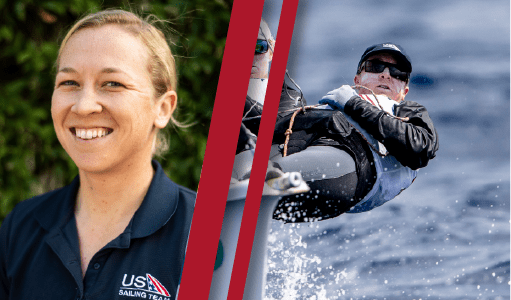
Maggie Shea, 49erFX Crew
MEET Maggie
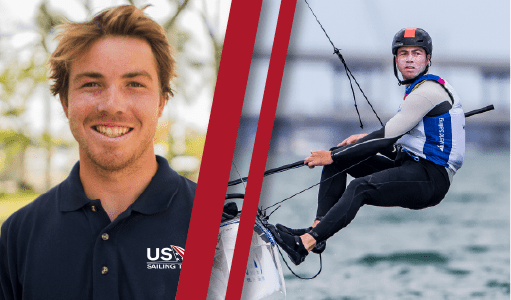
Riley Gibbs, Nacra 17 Skipper
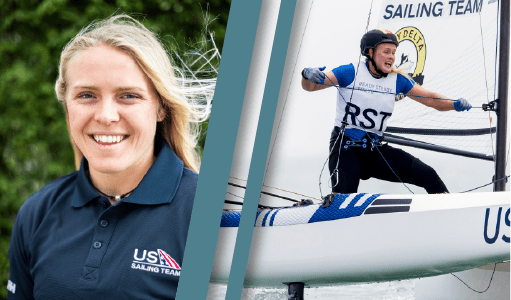
Anna Weis, Nacra 17 Crew
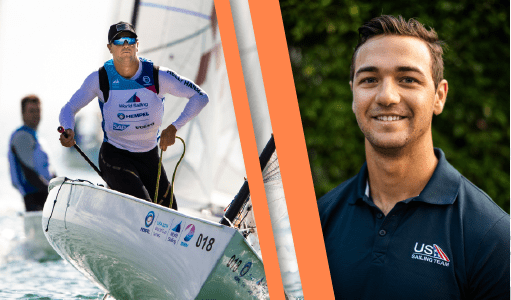
Luke Muller, Finn
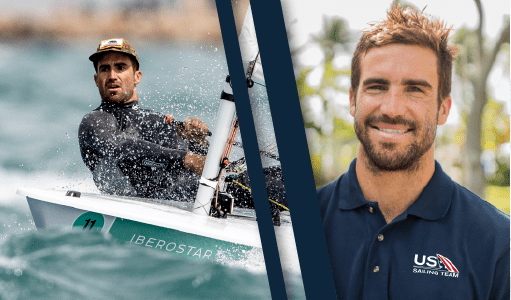
Charlie Buckingham, Laser
MEET Charlie
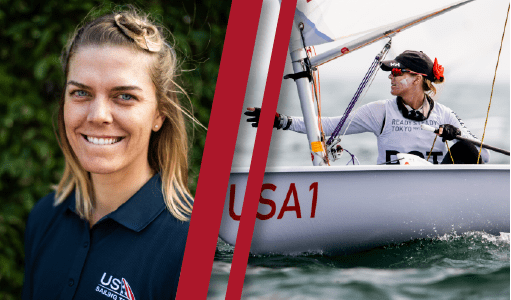
Paige Railey, Laser Radial
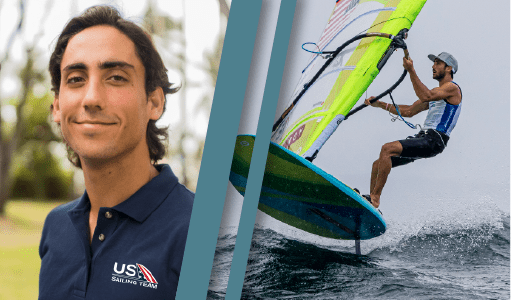
Pedro Pascual, Men's RS:X
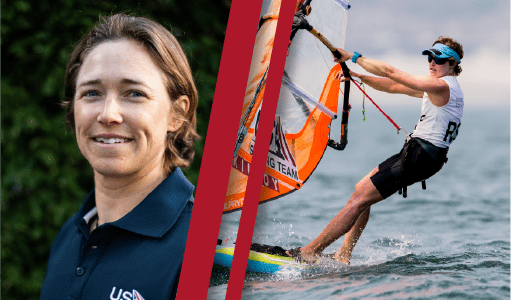
Farrah Hall, Women's RS:X
MEET Farrah
Click below to l earn more about the 2020 U.S. Olympic Sailing Team, including Olympic Qualification information.
U.S. Olympic Sailing Team
News & announcements.
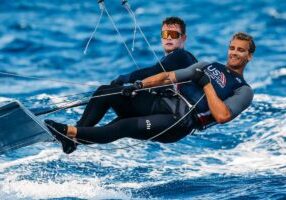
8th for Mollerus / MacDiarmid and Halfway to Paris 2024 49erFX Selection
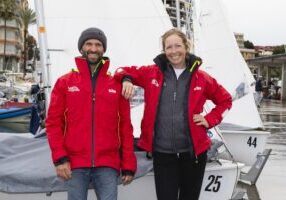
McNay & Dallman-Weiss Fully Qualified for Paris 2024
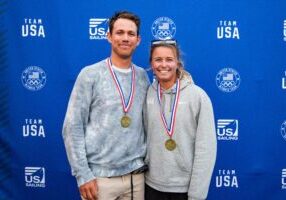
Reineke & F. McCann WIN U.S. Olympic Team Trials – Sailing
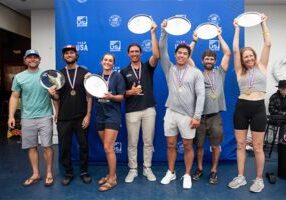
Final Update: U.S. Olympic Team Trials – Sailing
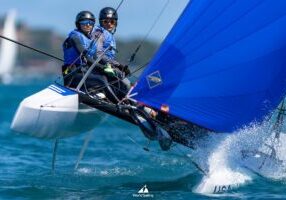
SILVER for Roe & Mertz at Youth Worlds, Five Top-10 Finishes for USA

US Sailing Names Marcus Lynch as High Performance Director
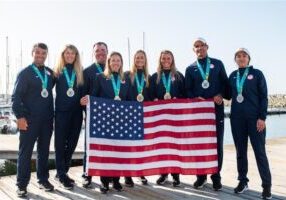
Medal Haul Continues for Team USA, Winningest Country of 2023 Pan Am Games
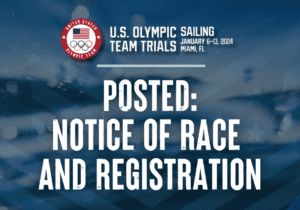
US Sailing Announces January 2024 U.S. Olympic Team Trials Notice of Race and Registration
![image002[9397440] 470 Men USA Foerster Paul - Burnham Kevin GOLD
Athens 2004 Olympic Games
August 21
© Daniel Forster](https://www.ussailing.org/wp-content/uploads/bb-plugin/cache/image0029397440-300x200-landscape-7967f65a322b54f80567178c519fd6bb-.jpg)
Apply now for US Sailing Foundation’s Kevin Burnham Memorial Grants & Nominate an Athlete for the Kevin Burnham Memorial Award
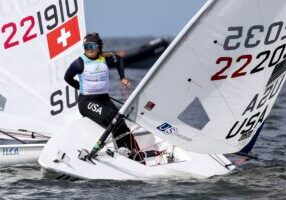

Day 10 Update: 2023 Sailing World Championships in The Netherlands
Rep the team, support the team.
Shop exclusive items from the Helly Hansen Supporter Collection and the US Sailing Store
Supporter Collection
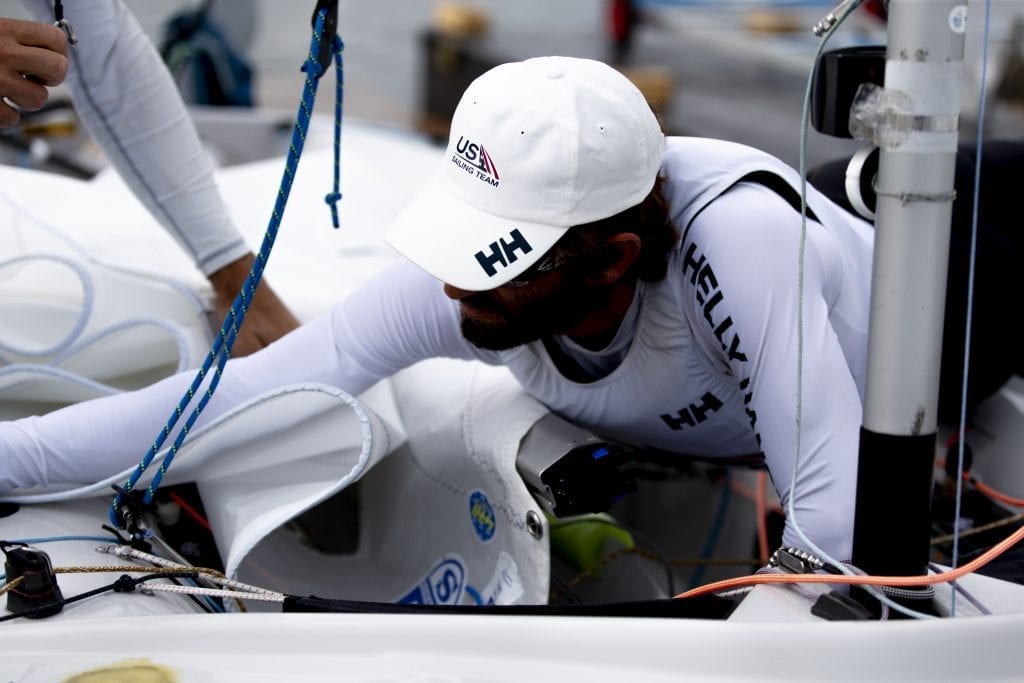
SUPPORT THE US SAILING TEAM
Donate today.
To subscribe to our e-mail distribution list for Media Contacts, or for more information about the 2020 U.S. Olympic Sailing Team, please send us a message at [email protected].
Send Us a Message
This content on this page is copyright of the United States Sailing Association. Any redistribution or reproduction of part or all of the contents in any form is prohibited. 2020 United States Sailing Association All Rights Reserved.
Copyright ©2018-2024 United States Sailing Association. All rights reserved. US Sailing is a 501(c)3 organization. Website designed & developed by Design Principles, Inc. -->
This story is over 5 years old.
Catamarans return to olympic games.
READ MORE: Surfing After A Shark Attack
Newberry and Whitehead racing the Nacra 17
ORIGINAL REPORTING ON EVERYTHING THAT MATTERS IN YOUR INBOX.
By signing up, you agree to the Terms of Use and Privacy Policy & to receive electronic communications from Vice Media Group, which may include marketing promotions, advertisements and sponsored content.

What Sailboats Are Used In The Olympics?

Last Updated by
Daniel Wade
May 19, 2023
Key Takeaways
- Laser is the most popular Olympic sailboat brand in the world
- Men and women compete with similar sailboats in the Olympics
- Olympic sports have evolved over time and so have the types of boat classes
- iQFoil and kiteboarding are making their first appearance in Olympic sailing
- Sailors have to adapt to certain boat types and be used to a course
Various types of sailboats are specifically used for Olympic sailing. But what sailboats are used in the Olympics?
The Laser Radial, RS:X, and Nacra 17 are a few of the sailboats used for Olympic games. These are used in different sailing competitions such as dinghy, high performance skiff, and mixed multihull. The Olympic sailing classes will vary and so will the boats being used.
Upon closer analysis, the Laser Radial is arguably the most popular boat when it comes to olympic sailing. A lot of these boats are also great for other activities on the water, not just Olympic competition.
Table of contents
The Types of Sailboats Used in the Olympics
Each time the Olympics occurs the types of races slightly change. This also changes the type of boat that is going to be used. The International Sailing Federation chooses the types of sailboats used in each Olympic games.
For the following boats we will look at the 2024 Olympics taking place in Paris . Men and women will use different boats. There will also be two new events for the first time ever known as iQFoil and kiteboarding so they will be making their Olympic debut.
Men’s Boat Types
The men’s class will be using the following boat types:
- Single handed or one person dinghy sailing: ILCA 7
- Men’s skiff boats: 49er
- Windsurfer (new) – iQFoil and kiteboarding
Women’s Boat Types
The women will compete with very similar boat types as follows:
- Single handed dinghy: ILCA 6
- Skiff: 49er FX (lighter and slightly smaller than the 49er)
- Windsurfer (new): iQFoil and kiteboarding.
Mixed Class
When looking at the mixed class of Olympic sailing they showcase:
- Mixed multihull for both men and women: Nacra 17 Foiling
- Mixed Two Person Dinghy for both men and women: 470
Boat Classification for Olympic Sailing
As mentioned, the boat types vary based on men’s and women’s racing events for Olympic classes. Each year the classification might change so sailors must be prepared to do their best for a medal race. But what do the boat classifications mean for Olympic world sailing?
Dinghy Sailing

Dinghy sailing uses a small boat meant for one individual to sail and is present in all events across the board for Olympic games. The most common dinghy boat that is raced for Olympic sailing is the ILCA 7 and was used recently in the Tokyo Olympics. The main difference is that the mixed class features a two person sailing competition or referred to as two person dinghy racing.
Windsurfing

Windsurfing requires strong winds in order to be successful. With a combination of strong wind conditions and the waves sailors must utilize both in order to succeed. For the first time ever in the Olympic games the men’s windsurfer and women’s windsurfer will be racing with iQFoil .
Skiff Racing

Skiffs are a flat bottom boat that are withered powered by sails or you can use oars. The women’s skiff uses the 49er FX which is slightly smaller and less weight than the men’s skiff. This allows easier handle for the women’s skiff races since there is less crew weight on board.
Multihull Racing

In multihull races it means that boats with more than one hull are competing. The Nacra 17 Foiling is a catamaran that uses a foil to help race. Depending on the type multihull race that is being ran will determine the type of multihull being used.
Boat Features That Make a Great Olympic Sailboat
A racing boat that is used for a sailing competition on the water is only as good as the person sailing it. However there are boats that are designed to go faster than others and make the difference in gold medals or none at all.
Types of Sails
The perfect combination of sails that are optimized for Olympic games are a bermuda sail and gaff sail. This allows the sailor to utilize more sailing area since there is limited pole space.
Since you have the combination of both sails, it allows you to powerfully sail without having the drawbacks from a longer pole such as difficulty maneuvering and strength needed to change direction. This means you can control the boat more efficiently.
Types of Rigging
Bermuda is the most common sail but gaffs are a close second. With a combination of both this means the rigging setup is likely different the just one or the other. Depending on the rig setup it might be best to operate a few different types in order to see which rigging is best for you.
Easy to Use
The best sailing boats in the Olympic games are ones that sail the fastest but are also the easiest to use. With proper training the boat might not matter a lot if you are experienced but every second matters. You want boats that allow you to execute a sailing plan and remain steady while using in medal events.
What is Olympic Sailing?
Olympic sports have had a variety of changes since the 1900’s. Sailing was introduced during this time and has been a part of the Olympics around 1908. Women were allowed to compete in 1988 for sailing and two Americans won a gold medal.
The phrasing was originally called yachting and then sailing in the 2000’s to help mirror the common way to describe boats on the water with sails. There have been many variations of sailboats that are used as well as the race types conducted. The boat types have grown into specific monotypes due to their size and weight.
How to Be an Olympic Sailor
In order to compete for the 2024 Paris Olympics sailors must compete in a variety of events in order to earn quotas such as the 2023 Sailing World Championships. There are certain qualifications that you must meet before applying.
Sailing World Championships
In August 2023 sailors will compete in the Netherlands to try to earn quotas for various racing events. The following events will take place and the amount of quotas will be given:
- Windsurfing: 11 for both men and women
- Kite: eight for both men and women
- Dinghy: 16 for both men and women and eight for mixed
- Skiff: 10 for both men and women
- Mixed Multihull: Nine
ILCA World Championships
Men and women that are not yet qualified for the Sailing World Championships can qualify for the dinghy events. The highest rated in the National Olympic Committee can compete for this in 2024 if they are not able to land a spot in the 2023 Sailing World Championships.
Continental Qualification
Sailors that have not yet qualified for the Sailing World Championships and the ILCA can receive quotas among various regions. There are 74 quotas in total that will be awarded which are going to be used for:
- 31 for women
- 12 for mixed
Last Chance
The highest ratings in the National Olympic Committee that are not yet qualified from the previous events can receive 34 quota places in the Last Chance Regatta. This event will take place some time in 2024 and include:
- Windsurfing: Five for both men and women
- Kite: Five for both men and women
- Dinghy: Three for both men and women and four for mixed
- Skiff: Three for both men and women
- Mixed Multihull: Three
Emerging Nations and Universality
Those that are part of the World Sailing Emerging Nations Program who have not yet qualified must compete in the Last Chance Regatta. Based on those results one man and women each per windsurfing and dinghy sailing can earn quotas.
In Universality places there will be four quotas total. Two are for the men’s while the other two are for the women’s. These are only for the dinghy races and are accounted for by the Tripartite Commission once the Last Chance Regatta has been completed.
Related Articles
I've personally had thousands of questions about sailing and sailboats over the years. As I learn and experience sailing, and the community, I share the answers that work and make sense to me, here on Life of Sailing.
by this author
Learn About Sailboats
Most Recent

Affordable Sailboats You Can Build at Home
September 13, 2023

Best Small Sailboat Ornaments
September 12, 2023
Important Legal Info
Lifeofsailing.com is a participant in the Amazon Services LLC Associates Program, an affiliate advertising program designed to provide a means for sites to earn advertising fees by advertising and linking to Amazon. This site also participates in other affiliate programs and is compensated for referring traffic and business to these companies.
Similar Posts

Discover the Magic of Hydrofoil Sailboats
December 11, 2023

Hunter Sailboats: Are They Built for Bluewater Cruising?
August 29, 2023

What Is A Furler On A Sailboat?
August 22, 2023
Popular Posts

Best Liveaboard Catamaran Sailboats
December 28, 2023

Can a Novice Sail Around the World?
Elizabeth O'Malley
June 15, 2022

4 Best Electric Outboard Motors

How Long Did It Take The Vikings To Sail To England?

10 Best Sailboat Brands (And Why)
December 20, 2023

7 Best Places To Liveaboard A Sailboat
Get the best sailing content.
Top Rated Posts
Lifeofsailing.com is a participant in the Amazon Services LLC Associates Program, an affiliate advertising program designed to provide a means for sites to earn advertising fees by advertising and linking to Amazon. This site also participates in other affiliate programs and is compensated for referring traffic and business to these companies. (866) 342-SAIL
© 2024 Life of Sailing Email: [email protected] Address: 11816 Inwood Rd #3024 Dallas, TX 75244 Disclaimer Privacy Policy

- Nacra 17 Olympic

Flying an Olympic Powerhouse
The Olympic standard in multihull sailing worldwide. Now upgraded to fully foiling beast. The first leisure catamaran built to Olympic standards.
The revolutionary Nacra 17 Olympic is the ultimate multihull for athletes. Now with full foiling capabilities, the 17 is faster than ever. Since the 2016 Rio Olympics, sailors keep pushing boundaries and setting records. With continuous innovation, performance keeps getting better. A true powerhouse.
The Nacra 17 is the Olympic standard in catamarans. It is the world wide bench mark in profesional sailing. The Nacra 17 exhumes quality, speed and durability. Its curved foiling daggerboards give the cat space craft like features. The thrill to sail the Nacra 17 will stay with sailors capable enough the drive this high powered machine.
Usage Olympic racing Competitive racing Foiling
Crew 2 Mixed sailors

FLYING ON THE HIGHEST STAGE IN SPORTS
The original Nacra 17 was initially designed to follow World Sailing´s strict requirements for the Olympic multihull. It was fitted with curved daggerboards at the 2016 Olympic Games in Rio de Janeiro, to provide extra buoyancy and boost its efficiency both downwind and upwind. In response to recent developments and requirements, the next generation Nacra 17 Olympic has now been upgraded into
a fully foiling race machine. The Nacra 17 Olympic is designed in collaboration with Morrelli & Melvin, a world-famous design office known for many other successful multihull projects. The Nacra 17 Olympic ‘s base obviously lies in the performance of the America’s Cup boats, also involving Morelli & Melvin. Once you start flying a Nacra 17 Olympic , you’ll realize its tremendous power on the water.
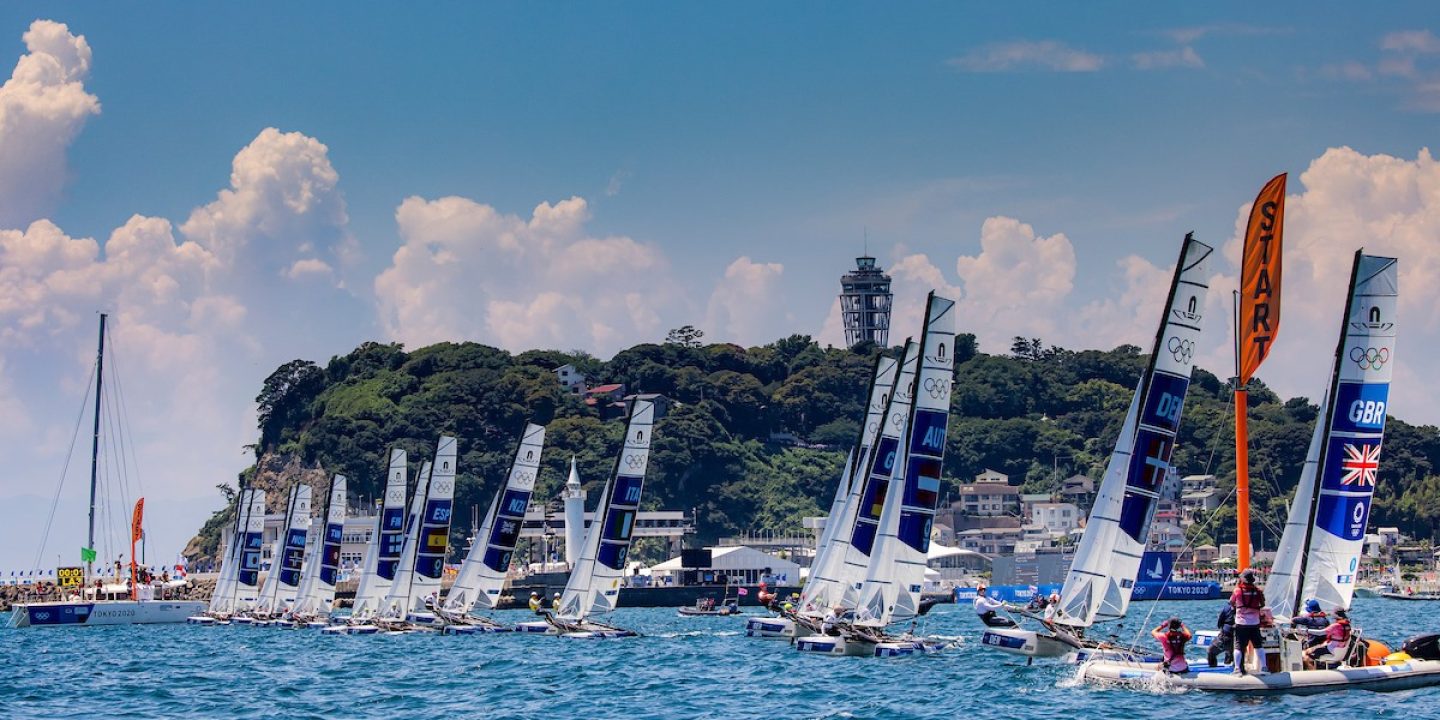
UPGRADED FOILING Challenging, exciting and dynamic – the next gen Nacra 17 Olympic is taking catamaran sailing to the next level. The quality standards for rigging, hull contruction and sail plan are unprecedented. The full carbon set-up engineered by a team of dedicated professionals has shown not only full foiling speed records but surprising durability at the same time. The Nacra 17 Olympic comes standard in the full Olympic configuration, with curved and Z-foil daggerboards. Sailing the next gen Nacra 17 Olympic takes guts, physical strength, tactical ability and focus – a true Olympian’s craft.

NEW SAIL PLAN Being the only multihull sailmaker in the world granted the right to make official Olympic sails by World Sailing, Performance Sails delivers high quality hand made sails. Their 30+ year expertise in the catamaran racing world makes sure your sails can handle anything. The Pentex™ mainsail and jib are strong and durable, as is the polyester spinnaker. Since 2016 Performance Sails offers fully printed spinnakers with your country’s flag or sponsors, with a negligible weight increase of only ~0.2g/m 2 .
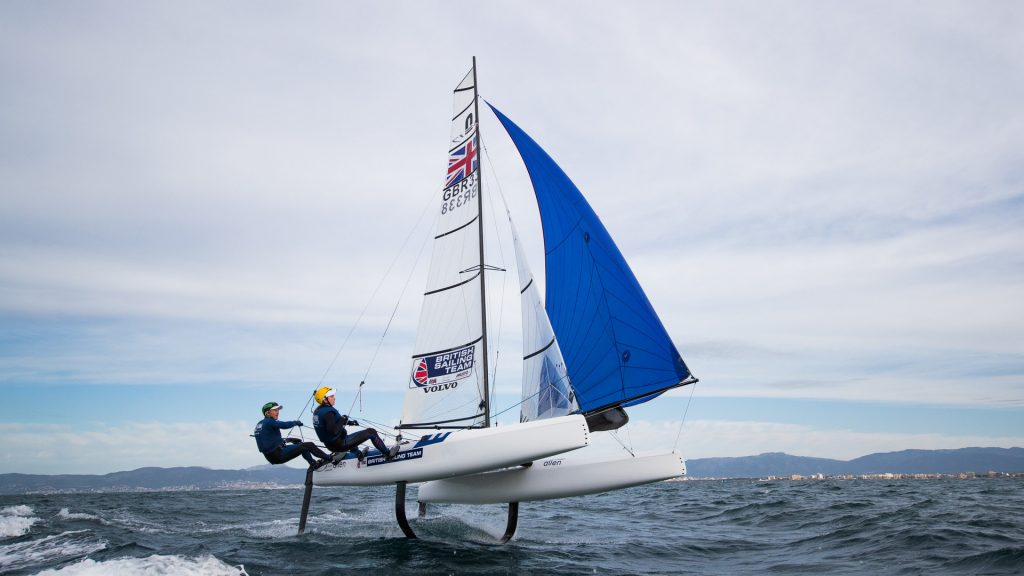
- Nacra Users & Owners Manual
- Nacra Assembly Manual Nacra 15 / F16 / 17 / F18 / F20
- Nacra Assembly Manual Nacra 17 Olympic V2
- Nacra 17 Front Crossbar
- Nacra 17 Rear Crossbar
- Nacra 17 Spinnaker Pole
- Nacra 17 Spinnaker Pole (Sloop)
- Nacra 17 Tillerbar
- Nacra 17 Olympic Rudder Template
- Nacra 17 Olympic Rudder Manual (2018)
- Nacra 17 Olympic Differential Rudder Rake Manual (2022)
- Nacra 17 Olympic Front Crossbar
- Nacra 17 Olympic Footstraps
- Nacra 17 Olympic DB Trimwheel Line System
- Nacra 17 Olympic Continuous Line System
- Nacra 17 Olympic Daggerboard Case Line System
Specifications
Ready to start flying.
ON SELECTED MODELS
All models outfitted with an Foiling Package ( FCS or Flight Control System for short ) are ready for full foiling – during your sail, specialized hydrodynamic daggerboards combined with upwards pressure make you get a controlled ‘flight’, meaning your whole boat will be above the water, rather than in it. Make alterations on the water during your flight to find the groove you are looking for and fly over water to leave others behind.
These so-called Foil sets are designed to fly in a wide range of weather conditions, to make competitive catamaran sailing accessible to even more sailors, and are built to meet the highest safety standards. A real treat for the more, or a little less, experienced sailors.
Using the best possible manufacturing techniques available, we’ve obtained maximum strength with minimum weight using autoclave technology, curing the pre-impregnated carbon/epoxy at 120 degrees Celsius at an atmospheric pressure of 6 bar. It will put you miles ahead of any fleet in terms of performance and joy.
Nacra 17 Class
The Nacra 17 class organization is involved in every step the Olympic boat takes. After the Olympic Games in Rio de Janeiro, the class and Nacra Sailing agreed to evolve the boat to become a full foiling catamaran. The Nacra 17 class is open to any sailor with Olympic ambition.
Nacra 17 Class website
See all Nacra models
Shop all your spare parts and accessories directly from our online store.
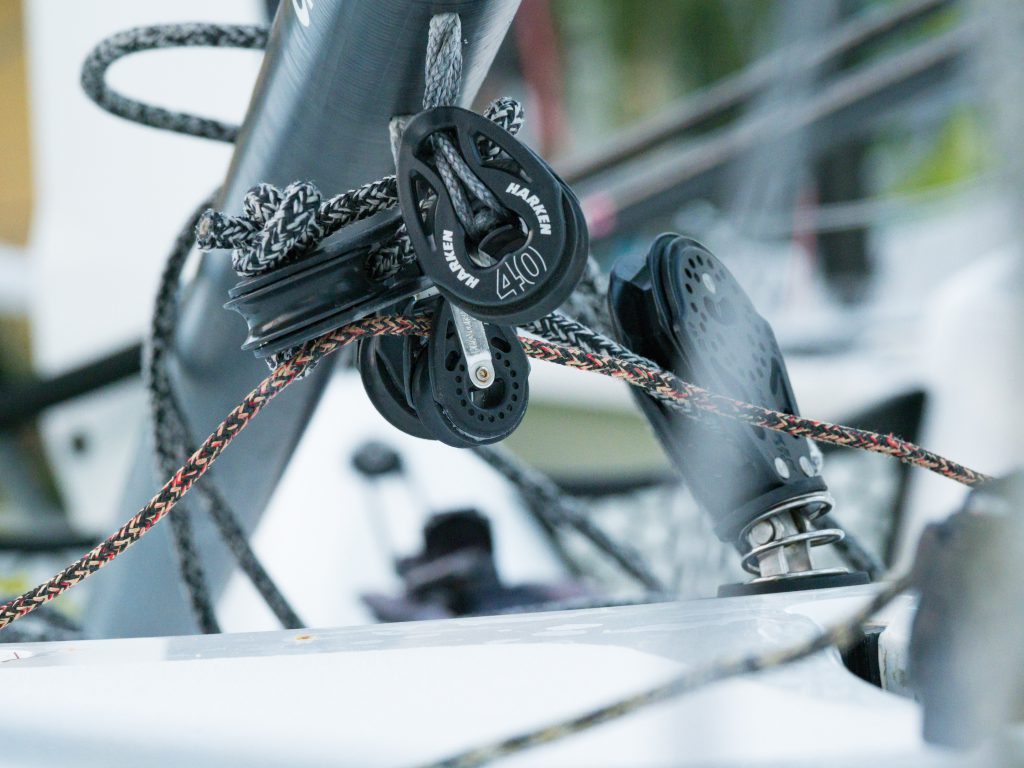
Shopping for your business?
Do you order for a sailing school or club, a resort, or do you want to become a Nacra Certified Dealer? Contact Nacra Sailing to apply.
© Nacra Sailing INT. 2024

- CLASSIFIEDS
- NEWSLETTERS
- SUBMIT NEWS
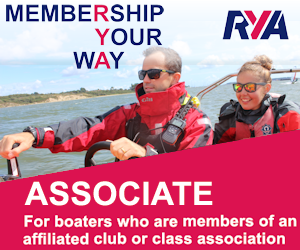
Ultimate Boat Company 'Olympic 32'
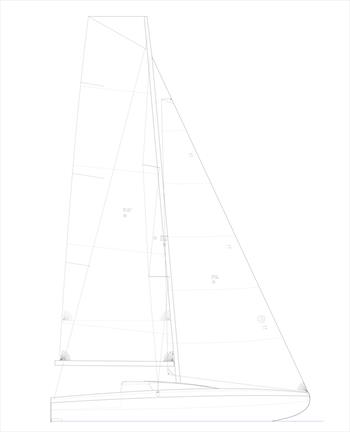
Related Articles
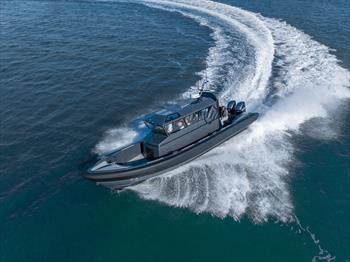
- Xinhua Headlines
- Xinhua New Media
- Special Reports
- B&R Initiative
- Biz China Weekly
- Asia & Pacific
- North America
- Latest News
- Watch China
- Asia & Pacific
China's Olympic spirit thrives after 20 years
by Sportswriter Su Bin
BEIJING, July 13 (Xinhua) -- With 10 days to go before the 32nd Olympic Games open in Tokyo, China's elite athletes are making their final pushes toward the delayed sporting extravaganza.
Exactly 20 years ago, hundreds of millions of Chinese reveled in Beijing's successful bid for the 2008 Olympic Games, the first to be held in the world's most populous nation and the first in an Asian city since Seoul staged the 1988 Games.
As much of the world is still grappling with the COVID-19 pandemic, the Olympic flame symbolizes a light at the end of the dark tunnel for the Olympic family and the world as a whole.
For the Chinese, the Olympics represented a century-old dream which reached its climax 13 years ago when they staged a Games described as "truly exceptional" by then-International Olympic Committee (IOC) President Jacques Rogge.
But China's Olympic dream didn't stop in 2008. The country continues to contribute to the Olympic movement.
CENTURY-LONG ANSWER TO THREE KEY QUESTIONS
In 1908, "Tianjin Youth" magazine raised three questions: "When could China send an athlete to participate in an Olympic Games?" "When could China send a delegation to an Olympic Games?" "When could China host an Olympic Games?" For most of the last century, Chinese people tried hard to give answers to those three questions.
The first two questions found their answers not very long afterwards while the final puzzle was only solved almost a century after it was made.
At the Amsterdam Olympic Games in 1928, Song Ruhai, an observer from the All-China Sports Promotion Association, was the first Chinese to hear the word "Olympiad". He thus transliterated the word as "Wo Neng Bi Ya," which means "I can compete" in English.
Four years later, Liu Changchun was the first Chinese to make "Wo Neng Bi Ya" a reality. After 28 days of travel, the student from Northeast University arrived at the Los Angeles Games but found himself eliminated in the men's 100m preliminaries. In 1936, some 140 Chinese athletes participated in the Berlin Games.
In 1952, China dispatched a 40-member delegation to the Finnish capital of Helsinki to participate in the 15th Olympic Summer Games, marking the first time that the national flag of the People's Republic of China was raised at the quadrennial sports event.
It was not until the year 1984 that China made a significant impression at an Olympic Games, 52 years after Liu Changchun first took part. Chinese sharpshooter Xu Haifeng won the country's first-ever Olympic gold medal, and the Chinese team grabbed a total of 15 golds.
However, the search for an answer to the third question was painstaking. China failed in its first Olympic bid in 1993 and came back for its second try eight years later.
On July 13, 2001, then-IOC president Juan Antonio Samaranch announced during IOC's 112th session in Moscow that Beijing was awarded the 2008 Olympic Games, igniting the Chinese people's enormous enthusiasm for the Olympic movement and pride in their motherland's achievements.
"In the old days, Chinese people dared not imagine that this country could host the Olympic Games. It has become a reality along with the escalation of our country's status in the international community and our economic development. Beijing's success is a grand victory of our Party, our country and our people," said renowned Chinese basketball coach Mou Zuoyun after Beijing won the bid.
Mou had wanted to watch the Beijing Olympics, but he passed away in 2007.
He said that Beijing's bidding success could not be disconnected from outstanding achievements that China had made in terms of economy, culture, sports and other areas since the country's reform and opening up.
Late IOC member and vice president He Zhenliang was best known for his role in helping Beijing land the 2008 Olympics.
He could not hold back tears when receiving congratulations from other IOC members and his friends.
"I have no pity in life after this," he said, also attributing Beijing's bidding success to the overall development of the city and the country.
"Those members who supported us become more staunch, while those who were against Beijing's bid changed their minds."
OLYMPIC PREPARATION
13 years later, nobody can ignore the threat posed by the COVID-19 pandemic to the Olympic movement, especially with the Tokyo Olympics being postponed by one year.
However, like their counterparts in other places, Chinese athletes showcased an unswerving faith in striving for Olympic glory.
Two-time Olympic taekwondo gold medalist Wu Jingyu turns 34 on Tuesday. Starting her Olympic campaign by pocketing gold on home soil in 2008 and defending it in London four years later, she is ready to make a record fourth Olympic appearance as a female taekwondo athlete.
"I just knew that I had won the gold medal but had no idea of why I won it. When everyone cheers for you, you just have a sense of pride," Wu recalled.
Wu retired after finishing seventh at the Rio Olympic Games, and gave birth to her daughter in 2017.
After deciding to return to competition, Wu faced a race against time to rack up enough ranking points to qualify for Tokyo. Despite enormous challenges, she managed to secure her spot after finishing runner-up in the women's under-49kg category final at last year's World Taekwondo Grand Prix Final in Moscow.
"For a moment during that period, I even doubted whether I used to be a taekwondo athlete or not," Wu recalled.
But her faith in herself never faded. "No one knows what will happen next, but I always want to challenge the top podium."
Like Wu, veterans persevere in chasing their dreams out of pure love for the sport, while some others are set to debut at an Olympics that will be quite different from previous editions.
Scooping 28 out of 32 gold medals on offer since 1988, China is undoubtedly a powerhouse in table tennis. Anything less than a clean sweep of all available Olympic gold medals would be deemed a failure.
"That's a weight off my mind," said women's singles world No. 1 Chen Meng after being named in China's Olympic table tennis roster.
The Chinese team competed and trained overseas amid the initial COVID-19 outbreak early in 2020.
"We took care of and helped each other this year, and this united group has produced an excellent Chinese team," commented Qin Zhijian, secretary-general of the Chinese Table Tennis Association (CTTA).
In search of another title sweep, the team has finished its behind-closed-doors training in east China's city of Weihai.
"We have the ability and confidence in contending for all five golds, but there are challenges and risks as well, especially considering the pace and manner of preparation is quite different during the COVID-19 pandemic," noted CTTA president and sporting legend Liu Guoliang.
CONSISTENT CONTRIBUTION TO OLYMPIC MOVEMENT
Less than half a year after the Tokyo Olympic Games draws to a close, the world's attention will shift to Beijing, the first city to host both Summer and Winter Olympic Games.
In 2003, Li Jiulin was appointed chief engineer of the construction of the Beijing National Stadium the "Bird's Nest" for the 2008 Olympics at the age of 35.
"At that time, no one in China had the experience to deal with such complicated structural steel construction. None of the foreign experts believed that we could finish the job by ourselves," he recalled.
To solve endless problems, Li and his colleagues completed 13,520 construction drawings based on 150 designs and eventually built the Bird's Nest, the flagship venue of the 2008 Beijing Olympic Games.
After Beijing won the bid for the 2022 Winter Olympic Games, Li was tasked with being the chief engineer of the National Speed Skating Oval, known locally as the "Ice Ribbon," due to its distinctive facade.
As the only newly-built venue for ice events in the Beijing competition zone, the "Ice Ribbon" has an ice surface of around 12,000 square meters and can seat 12,000 spectators, making it the largest speed skating venue in Asia.
Except the "Ice Ribbon", China has made efforts to repurpose existing venues from when it hosted the Summer Olympics as 11 venues from Beijing 2008 have been renovated and upgraded for the 2022 Games.
The National Aquatics Center, also known as the "Water Cube," hosted aquatic events during the Beijing Olympic Games and will stage the curling events for Beijing 2022. The National Indoor Stadium will be used for ice hockey, and the "Bird's Nest" is the planned venue for the opening and closing ceremonies.
IOC President Thomas Bach has lavished praise on the Beijing 2022 strategies. "Beijing is making the best out of this because the organizing committee there is using the great legacy of Beijing 2008 for the Olympic Winter Games Beijing 2022," he said.
On May 15, 2020, Beijing 2022 organizers released a sustainability plan that features three key themes: positive environmental impact, a new development for the region and better life for the people. They are supported by 12 sustainable development actions, under which there are 37 critical tasks and 119 specific measures.
"It (sustainability plan) is among the most developed in the history of the Olympic Games," said chairman of IOC Coordination Committee for Beijing 2022 Juan Antonio Samaranch Jr.
The BOCOG's Legacy Report released on June 23 outlines the pre-Games legacies achieved by Beijing 2022 in 13 areas, including the popularization and development of winter sports, urban transformation and upgrade, and regional transformation contributions to poverty alleviation.
Beijing 2022 will be held at a monumental moment, as China has realized its goal of building a moderately prosperous society in all respects.
According to the Legacy Report, a record 224 million Chinese people participated in ski and skating activities during the 2018/19 winter season, approaching the country's objective of involving 300 million Chinese people in winter sports.
In terms of urban upgrades and post-games sustainability, BOCOG has renovated and upgraded six venues from Beijing 2008 Games venue legacies to accommodate winter sports, and all permanent venues have sporting and social legacy plans for post-Games usage.
Over one million people at home and abroad have applied to volunteer during the 2022 Olympic and Paralympic Games, further evidence of the legacy and spirit of volunteerism stemming from the 2008 Olympic Games.
China has built an increasingly closer connection with the Olympic movement over the last 20 years and is set to play an ever more prominent role going forward. Enditem
- Organizations
- Doing Business
- Work in China
- Study in China
- Visit China
- Live in China
- Corrections
- People's Daily
- China.org.cn
- english.cctv.com
- China Daily
- Qiushi Journal
My Naughty Spirit | Olympic Marina | Lagoon 46
Olympic marina, lavrion, greece.

Availability
Thu Mar 21 2024
Mar 23 - Mar 30
Mar 30 - Apr 6
Apr 6 - Apr 13
Apr 13 - Apr 20
Apr 20 - Apr 27
Apr 27 - May 4
May 4 - May 11
Boat Details
Description.
My Naughty Spirit catamaran is Lagoon 46 with 13.99 meters length and 7.96 beam meters. It is docked in Olympic Marina. It has 2x57HP engine. My Naughty Spirit has 6 cabins for max 10 people onboard, beside of this it has 5 toilet and shower and 600.0 water capacity. It has Snorkeling equipment, Refrigerator, Autopilot, Inverter, Air condition, Outboard engine, Lazy jack, Generator, Bimini, Cockpit cushions, Water maker, Chart plotter, Dinghy. Charter company of My Naughty Spirit is Hellenic Yachting.
Extras (Paid During Check-In)
End Cleaning 42ft Plus
obligatory per booking
Damage Waiver plus refundable security deposit 600 euro
Electric Scooter
Hostess (food not included)
Non refundable insurance for skippered charters
per booking
Skipper (food not included)
- China Edition

- China Daily PDF
- China Daily E-paper
World in need of Olympic spirit
By Chen Haiming | CHINA DAILY | Updated: 2022-01-29 07:49

The international community has been encountering one unprecedented challenge after another since entering the 21st century-from the ecological and environmental crisis, terrorism, regional conflicts and wars to populism, anti-globalization and "clash of civilizations".
Worse, for the past two years people across the world have been battling the COVID-19 pandemic, which is threatening to neutralize many of the achievements humans have made over the past few decades. The novel coronavirus has already infected more than 356 million people and claimed over 5.61 million lives, plunging humankind into the abyss of despair.
To overcome the devastating impacts of the pandemic not only on people's health and life but also on economies and society as a whole, we need a new shot of vitality, along with encouragement and hope, and the Olympic spirit and its values, among a few other things, can give us that much-needed encouragement to intensify our fight against the pandemic in the hope that we will succeed in the end.
It is with the Olympic spirit that the Beijing 2022 Winter Olympic Games will be held from Feb 4 to 20, and the Winter Paralympics from March 4 to 13.
Olympic spirit and its values
The Olympic spirit is embodied in the Olympic motto of "Faster, Higher, Stronger". To this, the International Olympic Committee added "Together" on July 29, 2021, in recognition of the unifying power of sports and the importance of solidarity against the backdrop of the raging pandemic in which the deferred 2020 Summer Olympic Games was held in Tokyo in July-August 2021.
To be sure, the Olympic spirit has always promoted solidarity. Sports is a universal language shared by people across the world. It helps bring humankind together by highlighting our commonalities regardless of our race, religion, ethnicity, nationality, culture and language.
When watching the performances of athletes at the Olympics, we not only appreciate their sportsmanship, but also develop a sense of global community, thereby breaking the barriers dividing humans. While the interlocking Olympic rings symbolize the unity of the five continents, the harmonious atmosphere at the Olympic Village echoes the idea of the people around the world being one big family.
The addition of "Together" to the Olympic motto highlights the important role of the Olympic Games in facilitating solidarity among people and countries around the world, and encourages them to deal with the toughest of challenges facing humanity, including the COVID-19 pandemic, with the hope of succeeding in their efforts.
In addition, the Olympic spirit also contributes to peace. While values such as solidarity, tolerance, and respect for pluralism and cultural diversity lead to peace, the Olympic Games, by bringing people together from across countries and regions, cultures and religions, promotes dialogue and deepens mutual understanding, leading to global peace.
That the Olympics promotes peace is evident in the tradition of Olympic Truce, which dates back to ancient Greece-way back in 9th century BC.
Olympic Truce was declared to provide safe passage for athletes, their families and spectators traveling to the Olympic Games before and during the event. As in the ancient past, Olympic Truce today represents the spirit of peaceful cooperation, because it prompts the participating sides to suspend conflicts, even wars.
In 1999, in order to find "peaceful and diplomatic solutions to the conflicts around the world", the IOC established the International Olympic Truce Foundation and the International Olympic Truce Centre in cooperation with Greece with a view to declare Olympic Truce before every Summer and Winter Games.
In 1993, Olympic Truce was revived through a resolution adopted by the 48th session of the United Nations General Assembly. Since then, the UN General Assembly has been adopting a resolution titled "Building a Peaceful and Better World through Sport and the Olympic Ideal" before every Olympic Games.
Adopting Beijing Winter Olympic Truce Resolution in December, the UN General Assembly called for the observance of Olympic Truce throughout the period from the seventh day before the start of the Beijing Winter Olympic Games until the seventh day following the end of the Winter Paralympic Games. The suspension of conflicts and wars will create a good opportunity for harnessing the power of sports to advance global peace and development.
Games promotes global peace
The Beijing Winter Games will uphold the Olympic spirit and its values by fostering an atmosphere of solidarity, resilience, peace, development, tolerance and understanding which, having been aligned with the UN Charter which calls for maintaining global peace and security, are vital to the international community to contain the pandemic and resolve regional conflicts.
Since China has always attached great importance to harmony in diversity, the Winter Games will highlight solidarity, tolerance and respect for cultural pluralism. Yet despite the pivotal role the Beijing Winter Games is expected to play in promoting the Olympic spirit and, through it, global peace and tolerance, the United States has announced a "diplomatic boycott" of the Games over "China's abuse of human rights". And not surprisingly, some other Western countries have joined the US in this divisive and controversial move.
The "diplomatic boycott", motivated as it is by ideological arrogance, stems from the misinterpretation of the pluralistic connotation of human rights, reflects the Cold War mentality of these countries, and violates the Olympic spirit and the principle of political neutrality enshrined in the Olympic Charter. The move is not only against the spirit of promoting dialogue on human rights, but also undermines the role of the Olympics in promoting global solidarity and cooperation.
IOC President Thomas Bach has put it aptly: "In today's fragile world with so much uncertainty, the Olympic Games are more than ever a powerful symbol of hope, peace and solidarity for all of humanity in all our diversity." Accordingly, the Beijing Winter Games calls for not just Olympic Truce, but also the suspension of all hostilities.
The author is a professor and director of the Center for Global Governance and Law, Xiamen University of Technology.
The opinions expressed here are those of the writer and do not necessarily represent the views of China Daily and China Daily website.
If you have a specific expertise, or would like to share your thought about our stories, then send us your writings at [email protected], and [email protected].

- Milano Cortina 2026
- Brisbane 2032
- Olympic Refuge Foundation
- Olympic Games
- Olympic Channel
- Let's Move
Olympic Games Moscow 1980
- Highlights & Replays
- Medal Design
Moscow 1980 The Brand
The official emblem was created by Vladimir Arsentyev. Above the Olympic rings, we find parallel lines in the shape of a pyramid and a five pointed star, which serves as a reminder of the flag of the Kremlin.
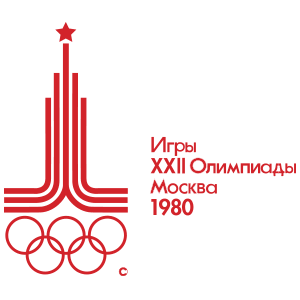
It featured the emblem of the 1980 Olympic Games in Moscow: a section of a running track rising into an architectural silhouette typical of Moscow and a five-pointed star topping the silhouette.
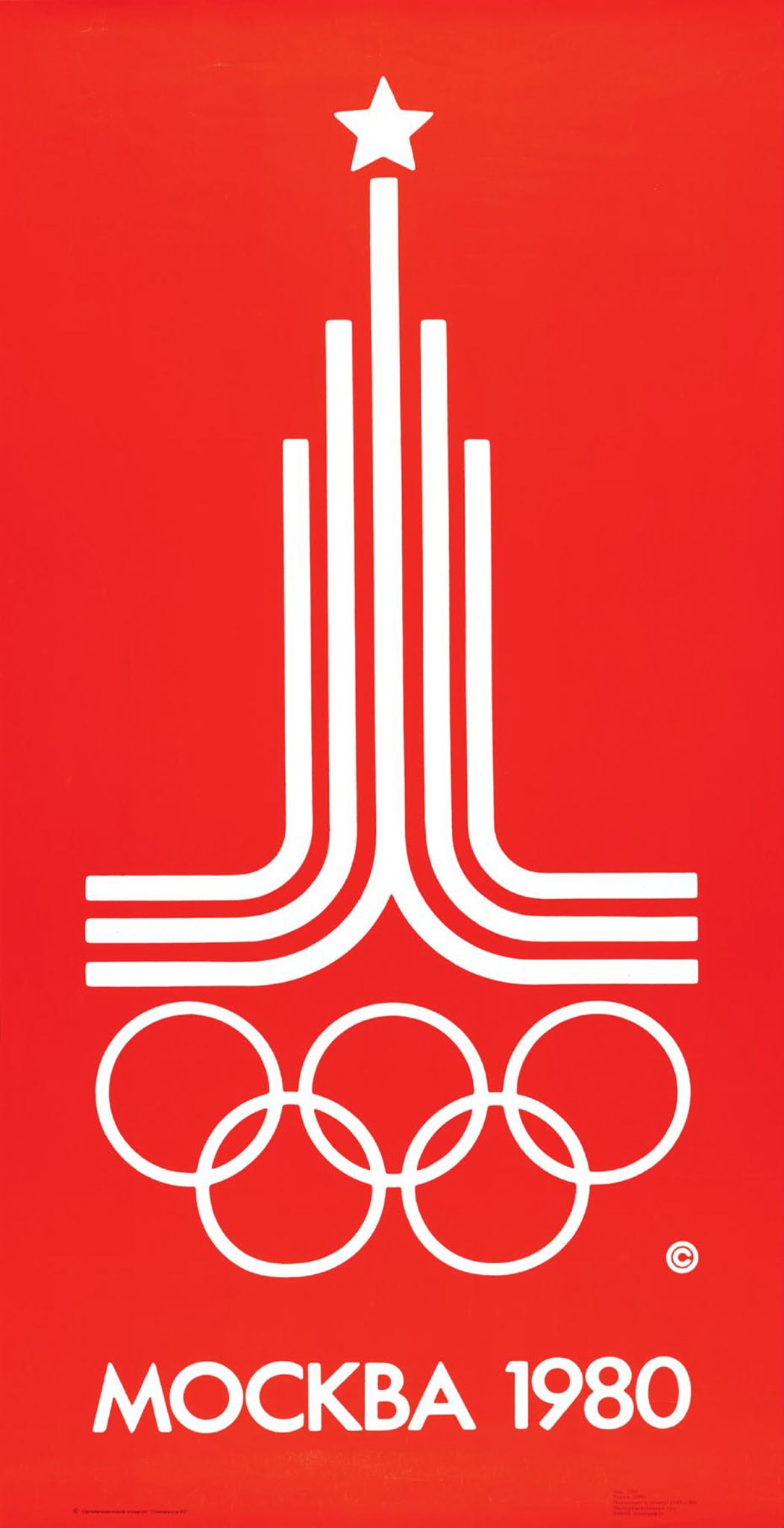
Discover the Games
Yachting World
- Digital Edition

First look: Olympic 32 designed for double-handed racing
- Rupert Holmes
- January 7, 2022
It may well be on hold for the time being but the Olympic 32 is an innovative eco-friendly concept for doublehanded racing
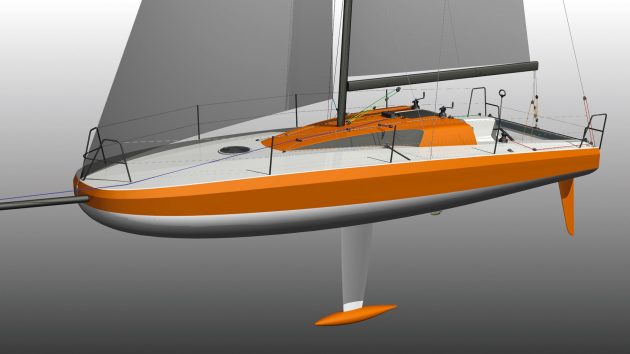
This short-handed one-design offshore race boat is a Finot-Conq design commissioned by the Ultimate Boat Company and aimed at the two-handed offshore class that was originally scheduled for the 2024 Olympics .
The radical scow bow hull is optimised for reaching and running, without regard to rating rules. Yet boats of this style are also now proven to be quick upwind and the polars show upwind VMG equivalent to that of a more conventional raceboat of similar size.
A huge amount of form stability enables the boat to stand up to a powerful sail plan and aft sections are shaped to promote early planing.
Light displacement of only 2,200kg puts this boat at the very high end of the performance spectrum – the Sun Fast 3300 is 3,500kg and even the Figaro 3 is 3,175kg. These factors make the Olympic 32 a boat with a performance profile that to date has only been available to Mini 6.50 and Class 40 sailors.
DANU recyclable composite is specified for the hull, deck, structural bulkheads and keel fin. As a result, it already exceeds World Sailing’s sustainable agenda that requires 90% of the weight of a boat to be recyclable by 2030.
Plans for the boat are on hold, although there’s also a proposal for a 33ft catamaran daysailer. In the meantime, the company is already producing RIBs and offshore workboats using DANU.
Olympic 32 specifications:
LOA: 9.45m 31ft 0in Beam: 3.5m 11ft 6in Draught: 2.5m Displacement: 2,200kg 4,850lb Upwind sail area: 68.6m2 738ft2 Price: TBD Builder: ultimate-boats.com
If you enjoyed this….
Yachting World is the world’s leading magazine for bluewater cruisers and offshore sailors. Every month we have inspirational adventures and practical features to help you realise your sailing dreams. Build your knowledge with a subscription delivered to your door. See our latest offers and save at least 30% off the cover price.

IMAGES
COMMENTS
The Tornado catamaran was for many years the fastest Olympic sailing class and was the first catamaran to be introduced to the Olympic Games. It was first sailed in the 1976 Olympic Games and saw ...
Olympic Spirit: Olympic Spirit is a sailing/power catamaran purpose built for the Sydney charter market. Her two decks offer ample room for entertaining in two cosy lounges and seated dining for up to 65 guests. Guests Ferry Trips: 130: Guests Party Cruises: 130: Guests Overnight: 8: Design: Custom: Length: 21.95m/72ft: Cruising Speed: 10 knots
Amada Cruises "Olympic Spirit", Dock 3, Auckland Ferry Terminal, Auckland. Guide for Amada Cruises "Olympic Spirit" events. "Olympic Spirit" 72 foot sailing Catamaran 2 lounges and three decks. Fully licensed. Nice spaces and great views Multi level to keep things ...
1997-2003A Brief Tornado History. The Tornado was designed in the autumn of 1967 by Rodney March from England, with help from Terry Pierce, and Reg White, specifically for the purpose of being the new Olympic Catamaran, which was to be selected by the IYRU in an Olympic Catamaran Trials. The boat was developed mainly in Brightlingsea, England.
Vessel Type: Catamaran Length: 72ft Build: Italian design - Aluminium Cruising Speed: 10 knots Number of Guest: 124 (71 seats on board at any one time - 55 in dining area, 6 on couches bar area, 10 top deck aft) Sleeping Berths: 14 guests Cabins: 4 cabins, 2 with 2 double beds and 2 with a double bed and single bed each Heads: 2 (+ private cabin)
The Olympic sailing at the Tokyo Olympics will feature 10 events between 25 July and 3 August 2021 at the Enoshima Yacht Harbor in Enoshima. No major changes have been made to the 2016 schedule ...
The first CM46 is a full carbon racing version destined for an Auckland-based owner and is due to launch early 2021. The second boat (for Wadhams) has a more cruising-oriented spec. Prices ex VAT ...
US Sailing has confirmed the names of the 13 sailors who will represent the United States at the Olympic Games this coming July and August near Tokyo, Japan. The team hails from nine U.S. states and territories including California, Florida, Illinois, Maryland, Minnesota, New York, Rhode Island, the U.S. Virgin Islands, and Wisconsin.
The previous Olympic catamaran was the Tornado class. In 2008, the Tornado class was open to both men and women, but the Tornado was a larger, heavier boat and the crews wound up being mostly men.
The Star Class has competed in every Olympics since 1932, except 1976 when it was dropped in favor of the Tempest two-person keelboat. Brought back into the Olympics in 1980, the Star is the oldest Olympic Class with Sydney 2000 its 15th Olympic appearance. Specifications. Length Overall. 6.92 metres.
The Laser Radial, RS:X, and Nacra 17 are a few of the sailboats used for Olympic games. These are used in different sailing competitions such as dinghy, high performance skiff, and mixed multihull. The Olympic sailing classes will vary and so will the boats being used. Upon closer analysis, the Laser Radial is arguably the most popular boat ...
The Nacra 17 is the Olympic standard in catamarans. It is the world wide bench mark in profesional sailing. The Nacra 17 exhumes quality, speed and durability. Its curved foiling daggerboards give the cat space craft like features. The thrill to sail the Nacra 17 will stay with sailors capable enough the drive this high powered machine.
The Island Spirit Catamaran Brand, three-time winner of the Top Ten Sail Magazine awards, is widely recognized for its spacious design and superior sailing performance. Originally manufactured and introduced in the United States in 1998, production was moved to Thailand in 2012 to provide competitive pricing while maintaining the highest build ...
This can be a perfect union - it's the Olympic Spirit in action!" This new keelboat will be built from a sustainable, super-tough composite called DANU. Named after the earth-mother goddess of the Tuatha Dé Danann, it takes its strength from the earth. ... twin masted catamaran sailing superyacht. Posted on 15 Mar Lowrance® introduces new ...
BEIJING, July 13 (Xinhua) -- With 10 days to go before the 32nd Olympic Games open in Tokyo, China's elite athletes are making their final pushes toward the delayed sporting extravaganza. Exactly 20 years ago, hundreds of millions of Chinese reveled in Beijing's successful bid for the 2008 Olympic Games, the first to be held in the world's most ...
The 10 classes competing in the Olympic Sailing event at Tokyo 2020 do not all start on the same day, with staggered starts days. The first fleets to start their regatta will be the Laser, Laser ...
My Naughty Spirit catamaran is Lagoon 46 with 13.99 meters length and 7.96 beam meters. It is docked in Olympic Marina. It has 2x57HP engine. My Naughty Spirit has 6 cabins for max 10 people onboard, beside of this it has 5 toilet and shower and 600.0 water capacity.
The Olympic spirit is embodied in the Olympic motto of "Faster, Higher, Stronger". To this, the International Olympic Committee added "Together" on July 29, 2021, in recognition of the unifying power of sports and the importance of solidarity against the backdrop of the raging pandemic in which the deferred 2020 Summer Olympic Games was held in ...
The Island Spirit 40, designed and built in South Africa, has many of the characteristics people look for in an offshore boat: solid construction, simple, robust, and accessible systems, safe and efficient sailhandling gear, a roomy interior, a manageable price, and good sailing performance.On deck we liked the mainsheet/traveler system and the good visibility over the coachroof from the
A visual identity is developed for each edition of the Olympic Games. Brand. The Medals Beginning as an olive wreath, medal designs have evolved over the years. Medals. The Mascot An original image, it must give concrete form to the Olympic spirit. Mascot. The Torch An iconic part of any Olympic Games, each host offers their unique version. Torch
To mark the anniversary, the Moscow Committee for Tourism has prepared a collection of sites where the Olympic spirit is still alive. Olympic Village and Cosmos Hotel. Over 5,000 athletes participated in the Moscow Olympics. The Olympic Village was built in the western part of Moscow to accomodate them. It consisted of 18 residential buildings ...
It may well be on hold for the time being but the Olympic 32 is an innovative eco-friendly concept for doublehanded racing. This short-handed one-design offshore race boat is a Finot-Conq design ...
Sunday, 19 July 2020. Forty years ago today, the most politically charged Olympics of modern times began when the distinctive chimes of the Kremlin were relayed to the Lenin Stadium by loudspeaker ...